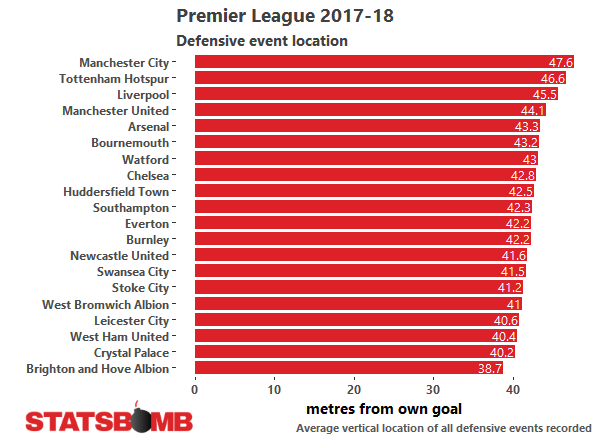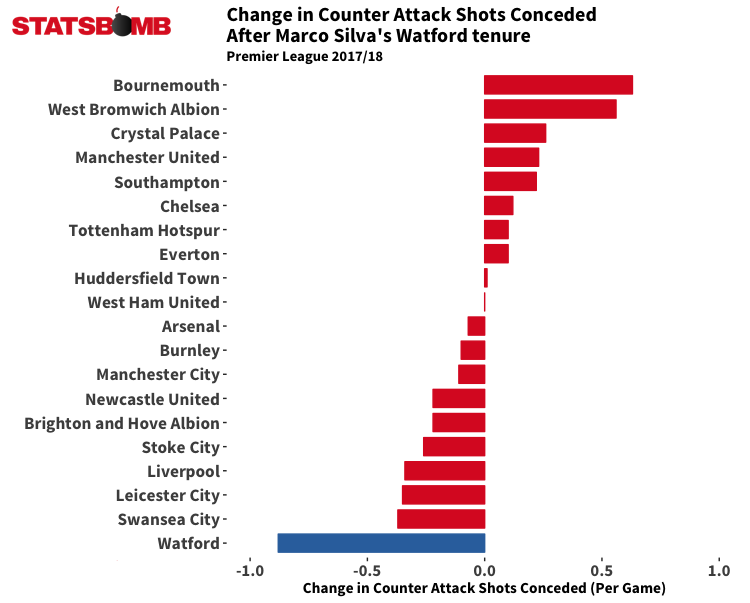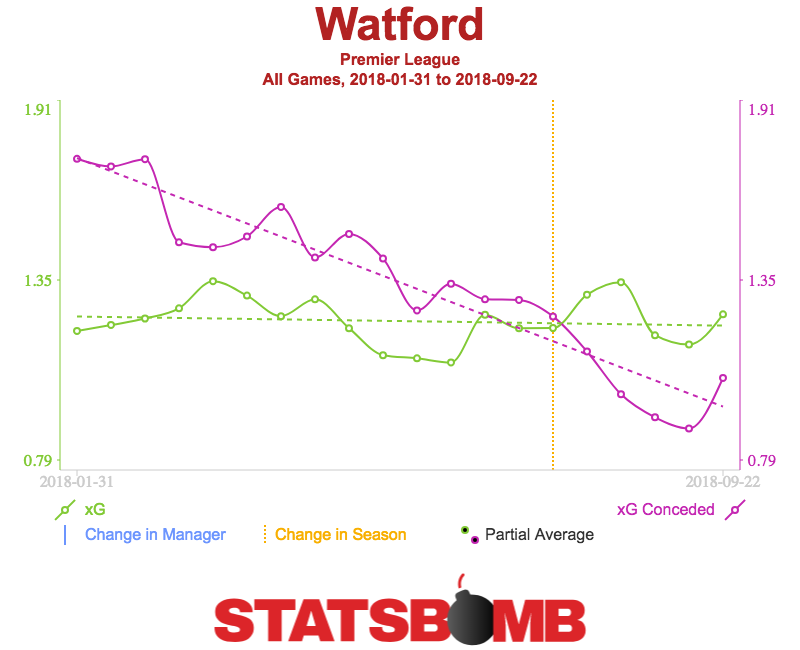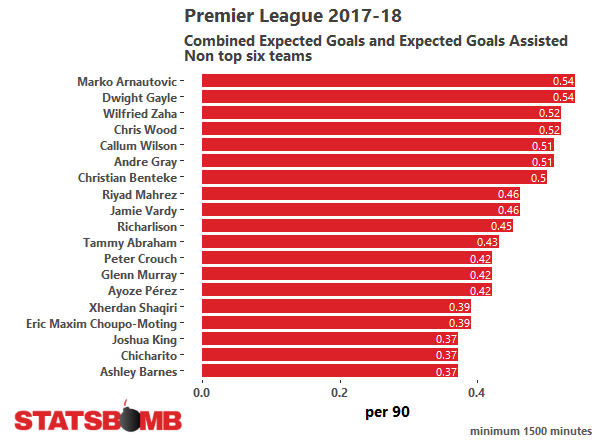So, Watford. Having front-loaded their drama with the firing of Marco Silva early in the Premier League season, Watford plodded to the sort of 14th-place finish that makes all but the most dedicated fans of the Hornets forget how they got there. Worry not, dear reader, for I am here to tell you that Watford under Javi Gracia has been about as boringly competent as you feared. Let’s dig in, yes?
Previously On…Watford FC
The 2017-18 version of Watford produced outcomes that were largely in line with its underlying numbers. The team generated 45.45 expected goals in the Premier League, good for 11th overall. On defence, The Hornets conceded 56.02 expected goals, the 16th best tally in the league. The real numbers in both categories — 41 non-penalty goals scored and 58 conceded — hint at a slight under-performance. Nothing in these numbers suggests Watford will continue to diverge from its expected goals going forward. When thinking about the style of play Watford might carry into this coming season, it’s worth focusing on what did and did not change with the appointment of Javi Gracia. The main constant is that Watford defended high up the pitch, especially for a team outside of the top-6, under both managers. The average distance from their own goal of Watford’s defensive actions did not change significantly or in a way that can be separated from happenstance after Gracia’s arrival.  Under Silva, this manifested as a sort of eagerness that fans and neutrals can find endearing but usually gets teams of Watford’s size mugged. Without radically changing the team’s basic vision — it still worked relatively high up the pitch and more than the average team on the flanks — Gracia appears to have addressed the team’s susceptibility to being picked off on the counter. The team ultimately conceded fewer counter-attacking shots per 90 minutes (0.61) than the league average of 0.63. The team’s expected goal difference splits, which largely align with Silva’s January departure, also showed an improvement in the second half of the season.
Under Silva, this manifested as a sort of eagerness that fans and neutrals can find endearing but usually gets teams of Watford’s size mugged. Without radically changing the team’s basic vision — it still worked relatively high up the pitch and more than the average team on the flanks — Gracia appears to have addressed the team’s susceptibility to being picked off on the counter. The team ultimately conceded fewer counter-attacking shots per 90 minutes (0.61) than the league average of 0.63. The team’s expected goal difference splits, which largely align with Silva’s January departure, also showed an improvement in the second half of the season.  Shot suppression was the other notable quirk of Watford’s defence. The team managed to concede nearly 1.5 fewer shots per 90 minutes than the average Premier League side. Taken on its own, that looks good. But Watford only succeeded in conceding fewer low-quality shots than the average team. In all but the lowest value expected goal buckets, the defence was average at best. All of this added up to a team whose average shot conceded had a notably high expected goals value and that still conceded enough shots to allow slightly more expected goals than the average team. It’s an interesting finding, but it doesn’t suggest that Watford has unlocked some secret of the game. Taken as a whole, though, the evidence on offer suggests Javi Gracia was able to turn Watford into a mid-table defensive side without sacrificing its attack.
Shot suppression was the other notable quirk of Watford’s defence. The team managed to concede nearly 1.5 fewer shots per 90 minutes than the average Premier League side. Taken on its own, that looks good. But Watford only succeeded in conceding fewer low-quality shots than the average team. In all but the lowest value expected goal buckets, the defence was average at best. All of this added up to a team whose average shot conceded had a notably high expected goals value and that still conceded enough shots to allow slightly more expected goals than the average team. It’s an interesting finding, but it doesn’t suggest that Watford has unlocked some secret of the game. Taken as a whole, though, the evidence on offer suggests Javi Gracia was able to turn Watford into a mid-table defensive side without sacrificing its attack.  Gracia’s preservation of Watford’s high-ish positioning, while fixing its susceptibility to counters, appears to have been consistent with his offensive vision. Under Marco Silva, Watford generated 2.38 high press shots per 90 minutes compared to a league average of 2.93. Under Gracia, Watford ramped up the high press shots to 3.21 against a league average of 2.95. Gracia’s version of Watford also improved to slightly above average on set piece expected goals. That latter change was less significant and may not mean anything in the long run, but it’s something to at least keep an eye on moving forward. The obvious temptation when discussing Watford’s attack is to focus on the now-departed Richarlison. This is understandable insofar as he accounted for about 20 percent of the team’s shots; the attack did often run through him. All of the Richarlison talk has served to obscure the development of Andre Gray, who produced an expected goals-per-90 average that was indistinguishable from his teammate’s. His expected goals assisted and per-shot numbers were also better. He likely has less upside than Richarlison in the long run, but he gives Gracia something interesting to work with.
Gracia’s preservation of Watford’s high-ish positioning, while fixing its susceptibility to counters, appears to have been consistent with his offensive vision. Under Marco Silva, Watford generated 2.38 high press shots per 90 minutes compared to a league average of 2.93. Under Gracia, Watford ramped up the high press shots to 3.21 against a league average of 2.95. Gracia’s version of Watford also improved to slightly above average on set piece expected goals. That latter change was less significant and may not mean anything in the long run, but it’s something to at least keep an eye on moving forward. The obvious temptation when discussing Watford’s attack is to focus on the now-departed Richarlison. This is understandable insofar as he accounted for about 20 percent of the team’s shots; the attack did often run through him. All of the Richarlison talk has served to obscure the development of Andre Gray, who produced an expected goals-per-90 average that was indistinguishable from his teammate’s. His expected goals assisted and per-shot numbers were also better. He likely has less upside than Richarlison in the long run, but he gives Gracia something interesting to work with.  There are, in point of fact, a fair few interesting pieces to work with on Watford’s squad. Outside of the top six, Roberto Pereyra contributed the most of any player to expected goal buildup. Remaining teammates Tom Cleverley, Abdoulaye Doucouré and Etienne Capoue were all also in the top ten of that list. Cleverley was one of the better players outside of the top six in terms of successful passes in the final third. None of this screams “Shock Title Winner!” but you can see something functional being pieced together with this squad. They could, for instance, provide some service to another forward, but who could that be?
There are, in point of fact, a fair few interesting pieces to work with on Watford’s squad. Outside of the top six, Roberto Pereyra contributed the most of any player to expected goal buildup. Remaining teammates Tom Cleverley, Abdoulaye Doucouré and Etienne Capoue were all also in the top ten of that list. Cleverley was one of the better players outside of the top six in terms of successful passes in the final third. None of this screams “Shock Title Winner!” but you can see something functional being pieced together with this squad. They could, for instance, provide some service to another forward, but who could that be?
Transfer Machinations
This is the bit where we talk a bit more about Richarlison, who has gone to Everton for £40 million. That economics of that transfer are now a concern for Toffees. Watford quadrupled its investment in a year, which is good business unless he turns into superstar. In terms of Watford’s coming season, though, it’s unclear how the Brazilian will be replaced. Richarlison registered a modest five goals and four assists in the Premier League last season while drastically underperforming his 12.05 expected goals. If you believe he’ll continue to have finishing problems that render his expected goals illusory, then his contribution is replaceable. Lots of not-very-good players chipped in five goals last season. It is not, however, clear why you’d believe Richarlison is doomed to underperform expected goals as he matures. The transfer fee negotiated by Watford and Everton suggests both clubs agreed Richarlison’s underlying numbers came closer to reflecting his true value. With Watford thus far on track to return last year’s squad, the loss of Richarlison’s potential could be an issue. Recall that the team mildly under-performed its expected goals, but by less than Richarlison’s 7-goal spread. His conversion issues were balanced out by things like Abdoulaye Doucouré scoring nearly twice as many goals as expected and assorted other low-quality chances turning into goals. Those things could happen again, but you wouldn’t bet on them. The prospect of Richarlison becoming as good as his underlying numbers in 2018-19 offered Watford a hedge against possible areas of decline and a source of upside if other things continued to go well. Without his contribution, the margins for Watford are narrower. To date, Watford has largely sat on the Richarlison windfall. If a rumoured £15 million Cardiff bid for the decidedly washed up and exceedingly replaceable Troy Deeney actually materialized, Watford would do well to take the money. Most of their transfer moves have been the myriad loans and minor deals one can expect from a Pozzo operation. Nordin Amrabat has been dispatched to Saudi Arabia. Gerard Deulofeu, who was previously with the club on a loan has been signed to…run in a straight line or something, I guess? He over-performed his expected goals to tally one goal last season, while mainly taking low quality shots from distance or strange angles. In 2018, one can safely say Gerard Deulofeu is not the answer.
So About This Coming Season
Javi Gracia’s defensive work with the club is real and encouraging. Over a full season, which would admittedly make for a long managerial tenure by Pozzo family standards, one imagines he could lead the team to something more solid than 16th in expected goals conceded. Most signs point to Watford being decent defensively. The team has more cushion to regress on last year’s mid-table offensive performance, which is probably for the best seeing as life without Richarlison and some fortuitous finishing could be messy. The team’s attack won’t look the same without him taking about 20 percent of the shots, but players like Andre Gray and Roberto Pereyra have upside and at least give Gracia some tactical options. Watford finished last season just ahead of parsimony’s very own Brighton and Hove Albion. Both teams amusingly had the same goal difference (so did chaotic West Ham, because life is funny.) The example of Brighton and Hove Albion is interesting insofar it suggests a team that scored and conceded slightly fewer goals than last year’s Watford could easily end up in roughly the same spot ultimately clear of relegation by a non-negligible margin, but not out of the woods until late in the season. Obviously underlying numbers vary and this year’s Premier League won’t shape up in exactly the same way, but it’s not the worst heuristic for thinking of the 2018-19 edition of Watford FC. The team’s upside is not high enough to expect big things or rule out relegation, but its downside risk is limited. Watford, in other words, could be a different proposition this year, and it might not change anything at all.
Thank you for reading. More information about StatsBomb, and the rest of our season previews can be found here.